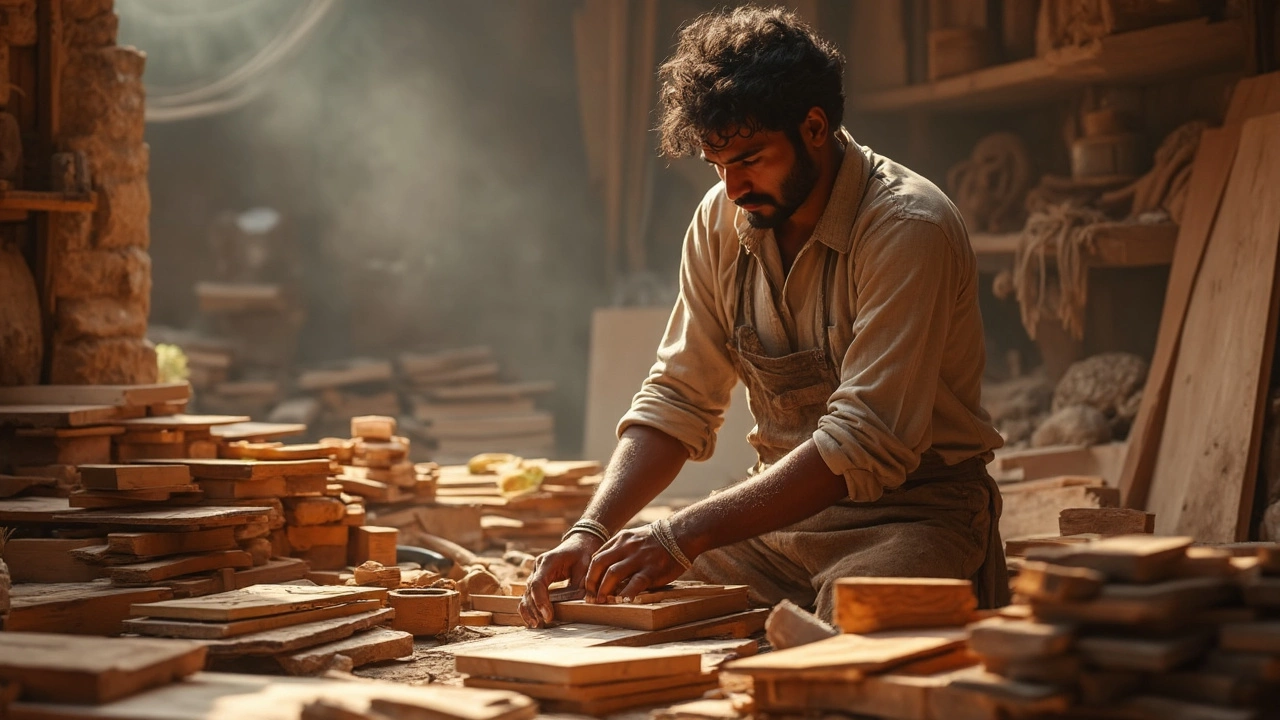The wood you choose for your bookshelf either sets you up for years of hassle-free reading—or endless repairs and regrets. There’s a reason that old libraries and stylish homes still have the same shelves standing tall after decades. It’s all about picking the right material from the start.
If you’ve ever seen a cheap bookshelf sagging in the middle, that’s usually because it’s made from low-quality wood or particleboard. Real wood (the solid stuff) can handle heavy loads, looks better over time, and even smells good when you open a book close by. Not all solid woods are created equal, though—some are strong enough to hold a dictionary collection, while others can barely handle a few paperbacks before bowing.
Thinking about the vibe you want to create? Light woods like maple and birch can make a room feel airy. Darker woods such as walnut kick up the warmth and bring a cozy feel. But don’t just pick based on looks—books are heavy, and most folks underestimate how much weight a shelf will bear over the years.
Before you get your heart set on a particular style, it helps to know the strengths and weaknesses of each wood and how they match up with your needs. Whether you’re a voracious reader or a casual book collector, the right picks mean less sagging, less moving, and zero wasted money on replacements down the line.
- Why the Wood You Pick Matters
- Top Woods for Tough, Reliable Bookshelves
- Budget Picks: Affordable Materials That Hold Up
- Tips for Building or Buying the Perfect Bookshelf
Why the Wood You Pick Matters
Think library shelves that haven’t budged in 50 years versus the $40 flat-pack that caves after a few months—what’s the difference? The wood. If you put in a bit of homework on this, you’ll skip a lot of the headaches that come from squishy shelves and surprise repairs down the road.
Books are a lot heavier than people think. A single foot of hardcovers can weigh over 20 pounds. Choosing the right best wood for bookshelf type isn’t just about how it looks—it’s about what can actually keep your collection up off the floor. Softwoods like pine are lighter and cheaper, but they’ll dent or warp under real weight. Hardwoods like oak or maple can take the punch, so they’re what you find in classic college dorm builds or old public libraries.
“If you want a bookshelf that stands the test of time, invest in hardwood over particleboard. Particleboard shelves have a lifespan for a reason,” says Doug Green, retired master carpenter at Woodcraft Magazine.
Here’s a quick look at some average load limits for common bookshelf woods (assuming a 1-inch thick shelf and a 30-inch length):
| Wood Type | Average Load (lbs/shelf) |
|---|---|
| Particleboard | 35 |
| Pine | 40 |
| Birch | 75 |
| Oak | 90 |
| Maple | 100+ |
Solid wood isn’t just about weight carrying. It also resists dents, dings, and daily wear way better than MDF or composites. For families with kids, pets, or big stacks of books, this durability is a game-changer.
So before heading to the store, ask yourself: Are you looking for a weekend quick-fix or a shelf that’ll outlast your book habit? The wood you choose sets the stage for how long your bookshelf stays strong and how little you’ll fuss with it in the years ahead.
Top Woods for Tough, Reliable Bookshelves
If you want your bookshelf to last—and actually hold all your books without buckling—it pays to pick strong, dependable wood. Here’s a breakdown of hardwoods and softwoods popular for sturdy shelves, plus a quick look at how they stack up against each other.
- Oak: This is the classic choice for heavy-duty bookshelves. Oak is tough, resists warping, and can take a beating. You’ll spot it in libraries and offices everywhere. The grain looks good stained or plain. If you need a best wood for bookshelf, oak belongs at the top of the list.
- Maple: It’s less flashy than oak but almost as strong. Maple won’t dent easily and holds screws tight, making it a solid pick for building or buying shelves meant for big books.
- Walnut: Look, walnut isn’t cheap, but it delivers on style and strength. It has a darker, richer vibe and won’t sag under weight, though it’s usually reserved for higher-end setups because of the cost.
- Cherry: Cherry wood ages well, getting even warmer and richer in color over time. It’s sturdy and can handle daily use, but you’ll usually pay a bit more for that classic look.
- Pine: Technically a softwood, but people use it a lot because it’s affordable and easy to work with. Pine shelves can handle lightweight books, but overloaded pine will start to bend. If you go this route, keep the shelf spans short.
If you like stats, here’s how common bookshelf woods compare for typical strength and price (based on average US retail values for finished boards square foot in 2025):
| Wood Type | Avg. Cost per Sq. Ft. | Hardness (Janka Scale) | Typical Uses |
|---|---|---|---|
| Oak | $7 | 1290 | Heavy books, classic shelves |
| Maple | $8 | 1450 | Textbooks, built-ins |
| Walnut | $15 | 1010 | Showcase, luxury shelves |
| Cherry | $11 | 950 | Decorative, upscale uses |
| Pine | $3 | 380 | Budget-friendly, light loads |
When picking wood, also consider what tools you have and how much weight your shelves will see. Hardwoods like oak and maple are harder to cut but hold up for decades. If you’re buying pre-made, check that the manufacturer isn’t using veneer over particleboard (which looks nice but sags fast). When in doubt, shorter shelves and more support brackets can help, but the right wood will always save you trouble in the long run.

Budget Picks: Affordable Materials That Hold Up
Want tough shelves without wrecking your wallet? You don't need to empty your savings to get a bookshelf that lasts. Some budget-friendly materials, like plywood and certain engineered woods, are actually pretty solid choices for everyday use. Here’s what to look out for before you buy or build.
Best wood for bookshelf on a budget often means plywood. Plywood is way stronger than particleboard, and with a nice veneer, it can look just as good as more expensive woods. If you’ve got hefty textbooks, thick novels, or big cookbooks, plywood won’t sag if the shelf is built right. Look for at least 3/4-inch thickness—that’s the sweet spot—so your shelves can handle more weight without warping.
Let’s break down the most popular budget choices and their pros and cons:
- Plywood: Multiple layers of wood glued together. It holds screws well and can be cut to any size. Choose a hardwood veneer (like oak or birch) for a classy finish at a lower cost.
- MDF (Medium Density Fiberboard): Smooth, flat, and great for painting. Cheaper than plywood, but it's heavy and doesn’t like moisture. Keep MDF bookcases dry, and they’ll last a long time.
- Particleboard: This is as cheap as it gets, but it’s also the weakest. If you’re only keeping light paperbacks, it can do the trick, but skip it for anything heavy. Laminate covers help with looks but don’t add strength.
Curious how much weight these materials can hold? Check out the numbers below (assuming you’re using a standard shelf about 30 inches wide):
| Material | Suggested Shelf Thickness | Estimated Load Capacity |
|---|---|---|
| Plywood | 3/4 inch | 50-60 lbs |
| MDF | 3/4 inch | 40-50 lbs |
| Particleboard | 3/4 inch | 25-30 lbs |
Want the most out of cheap materials? Install more shelf supports. Even a cheap shelf won’t sag if it’s got brackets every 20 inches or so. For plywood, use edge banding to hide the layers and it’ll look like a much pricier piece. Always pick a finish or paint that seals the wood well to protect against moisture, especially for MDF and particleboard.
If you’re buying ready-made bookshelves, check that the back is real wood or thick plywood and not just thin cardboard. A sturdy back can double the life of any cheap bookshelf. Small details like this are what set apart a smart purchase from landfill fodder.
Tips for Building or Buying the Perfect Bookshelf
Building or buying a bookshelf isn’t just about picking wood you like. There’s a bunch of practical stuff you need to consider if you want something that won’t disappoint after a few months of use. So, before you get started, let’s break down what actually matters.
- Measure Your Space: Double-check the height, width, and depth where your bookshelf will go. An average shelf depth is 10-12 inches—deep enough for big hardcovers but not so big that smaller books get lost in the back.
- Support Matters: The most common reason shelves sag is bad support. If you’re building your own, use thicker shelves (at least 3/4 inch for solid wood and 1 inch for plywood or MDF). Add a solid back panel or use wall anchors to help keep the bookcase square and stable.
- Shelf Spacing: Adjustable shelves give you flexibility—handy if you collect a mix of tall art books and regular novels. Standard spacing is 10-12 inches apart, enough for most books.
- Finishes Protect: Raw wood looks cool, but a tough finish (like polyurethane or lacquer) saves you from drink rings, scratches, and warping. Pre-finished plywood can be a time-saver for DIY builds.
- Weight Load: Not all woods are equal here. For example, softwoods (like pine) start sagging under about 20 lbs per foot, while hardwoods (oak, maple) can handle closer to 50 lbs per foot.
Here’s a quick look at how different materials stack up on durability and weight-bearing:
| Material | Average Weight Capacity Per Foot | Durability (1-5) | Common Issues |
|---|---|---|---|
| Solid Oak | 50 lbs | 5 | Heavy; pricey |
| Maple | 45 lbs | 5 | Hard to cut |
| Pine | 20 lbs | 3 | Sags, dents easily |
| Plywood (3/4") | 35 lbs | 4 | Edges need covering |
| MDF | 25 lbs | 2 | Sags, swells if wet |
If you’re buying instead of building, ask questions. Are the shelves solid wood or veneer? Are the joints screwed and glued or just tacked together? Flat-pack bookshelves are often made from particleboard, which is the last material you want holding your valuable collection. Look for units with solid backs, thicker shelves, and reinforcements under the middle of longer shelves.
And remember—the best wood for bookshelf jobs isn’t always the fanciest or most expensive. Sometimes, it’s the stuff that shows up, lasts, and doesn’t stress you out every time you add another stack of novels to your collection.

